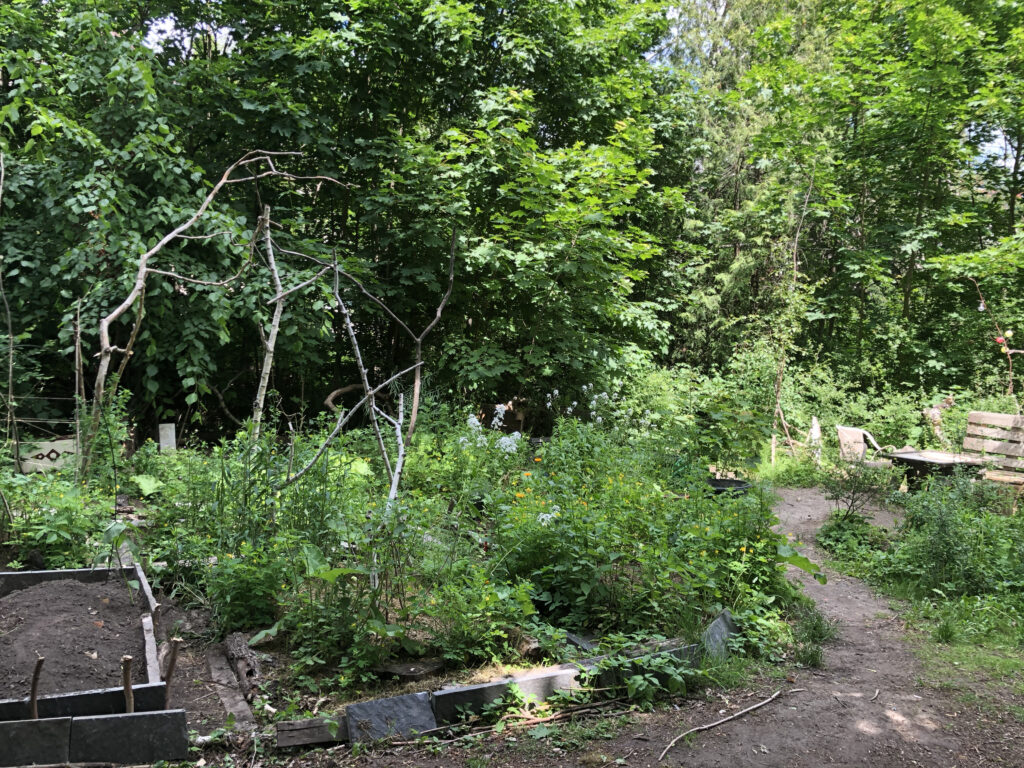Berlin is a city of gardens. Gardens are everywhere: along the streets, under the trees, in private yards, in cemeteries. The motto “Berlin braucht MEHR Gärten” [Berlin needs more gardens] has lately brought together community gardens, allotment gardens, associations and activists. Citizens are calling for environmental justice, while the city’s development strategies aim at urban densification, thus saturation of most of the few remaining free spaces in the city centre. Many urban gardens in Berlin are constantly jeopardised by urbanisation. Community gardens are progressively displaced to private or not (yet) buildable areas, while the fate of some allotment gardens is pending between the updates of KEP. Protecting Berlin’s gardens doesn’t just mean preserving natural areas and spaces for communities, it engages a more deep understanding.
The current pandemic time has shaded the light on the multiple values of urban gardens, as spaces that allow interspecies encounter, where humans can be both in psycho-physical isolation from the commitments of everyday life, as well as in a safe space shared by others with social distance. In urban gardens people grow food, build knowledge and recreate.
But what is a garden actually? The word “Garden” derives from the German word “Garten”, which refers to the word “enclosure”, thus the garden is a fenced land. Gilles Clément expanded this concept in his book “Planetary garden”, with his clear vision that opposes the anthropocentric observation of the world.The concept of “Planetary garden” is based on the idea of exploitation and protection of the diversity of the planet, where human commitment (the role of the gardener) becomes fundamental and necessary.

Gardens have different forms and dimensions that cannot be ascribe in two or more typologies. From a theoretical to a pragmatic observation, the lability between living and gardens is extremely tangible in Berlin, if gardens are understood in a “planetary vision”. Apart from allotments and community gardens, public participation in the maintenance and improvement of greenery has a long tradition in the city. Minimum interventions such as insects hotels hanging on street trees, flowered Baumscheibe, pumpkins grown in flowerbeds, demonstrate how the city has become a garden in itself; a common ground of a variety of shared spaces.
In 2014, the manifesto “Die Stadt ist unserer Garten” [the city is our garden] has been signed by activists to claim spacial justice and ensure the permanent state of the gardens in the city. Six years later, the situation has only seen a decline. Among many others in the city, Prinzessinnengarten at Moritzplatz since last year is accessible to the public at limited hours, while part of the activities has been moved to the St.Jacobi cemetery and in constant danger of dismissing. Himmelbeet will follow the same story and the garden finds a new place at St. Elisabeth II cemetery. The gardeners from Peace of Land are waiting for the authorities to approve the project for a school building on the garden area. Prachttomate in Neukölln has been fighting for years against the construction of a residential complex on the land that the garden occupies. The activist Gabriele Gutzman from the allotment Am Stadtpark I is collecting signatures for saving part of the colony.
Each of these stories should be told as a “practice of resistance”, not only in favour of environmental protection but as actions against neo-liberal strategies and the constant monetisation of socio-ecological resources.
“Berlin needs more gardens” and urban natural spaces are reducing. The lack of space therefore becomes one of the reasons why different types of garden come together in a common battle. What will the urban gardens of the future be? Will urban gardeners be able to share visions, interests and common spaces?
“Today’s garden cannot contain itself within the traditional fence, on the contrary, it forces the whole neighbourhood into sharing. The insects, birds, oxygen and water know no other container than the surface of the earth and the thickness of the biosphere: they cross institutional barriers.” (Clément, 2013; translation by the author)
Bibliography
Clément, G 2013, Giardini, paesaggio e genio naturale, Quodlibet, Macerata.
Clément, G, Morris, S & Tiberghien, GA 2015, The planetary garden : and other writings, University Of Pennsylvania Press, Philadelphia.
